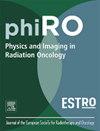中央肺立体定向消融放疗中危险器官邻近:四维计算机断层扫描和磁共振引导屏气传送技术的比较
IF 3.3
Q2 ONCOLOGY
引用次数: 0
摘要
较高的毒性率与立体定向消融放疗(SABR)对中央肺肿瘤有关。屏气(BH)磁共振引导SABR (MR-SABR)可以减少对危险器官(OAR)的剂量。我们量化了使用MR-SABR治疗的45个病变的规划靶体积(PTV)到OAR距离,并生成了相应的基于四维计算机断层扫描(4D-CT)的PTV(包含运动的内部靶体积加5mm)。对于距离气道≦3cm的病变,BH MR-SABR使PTV距桨叶的中位距离增加3.7 mm。病灶距心包≦3cm者,PTV-OAR中位距离随BH增加2.0 mm。这些发现突出了BH SABR在中枢性肺肿瘤中的优势。本文章由计算机程序翻译,如有差异,请以英文原文为准。
Organs at risk proximity in central lung stereotactic ablative radiotherapy: A comparison of four-dimensional computed tomography and magnetic resonance-guided breath-hold delivery techniques
Higher toxicity rates are associated with stereotactic ablative radiotherapy (SABR) to central lung tumors. Breath-hold (BH) magnetic resonance-guided SABR (MR-SABR) can reduce doses to organs at risk (OAR). We quantified the planning target volumes (PTV) to OAR distance in 45 lesions treated using MR-SABR and generated a corresponding four-dimensional computed tomography (4D-CT) based PTV (motion-encompassing internal target volume plus 5 mm). For lesions located ≦3 cm from airways, BH MR-SABR increased the median PTV distance to OAR by 3.7 mm. For lesions ≦3 cm from pericardium, median PTV-OAR separation increased by 2.0 mm with BH. These findings highlight the advantage of BH SABR for central lung tumors.
求助全文
通过发布文献求助,成功后即可免费获取论文全文。
去求助
来源期刊

Physics and Imaging in Radiation Oncology
Physics and Astronomy-Radiation
CiteScore
5.30
自引率
18.90%
发文量
93
审稿时长
6 weeks
 求助内容:
求助内容: 应助结果提醒方式:
应助结果提醒方式:


